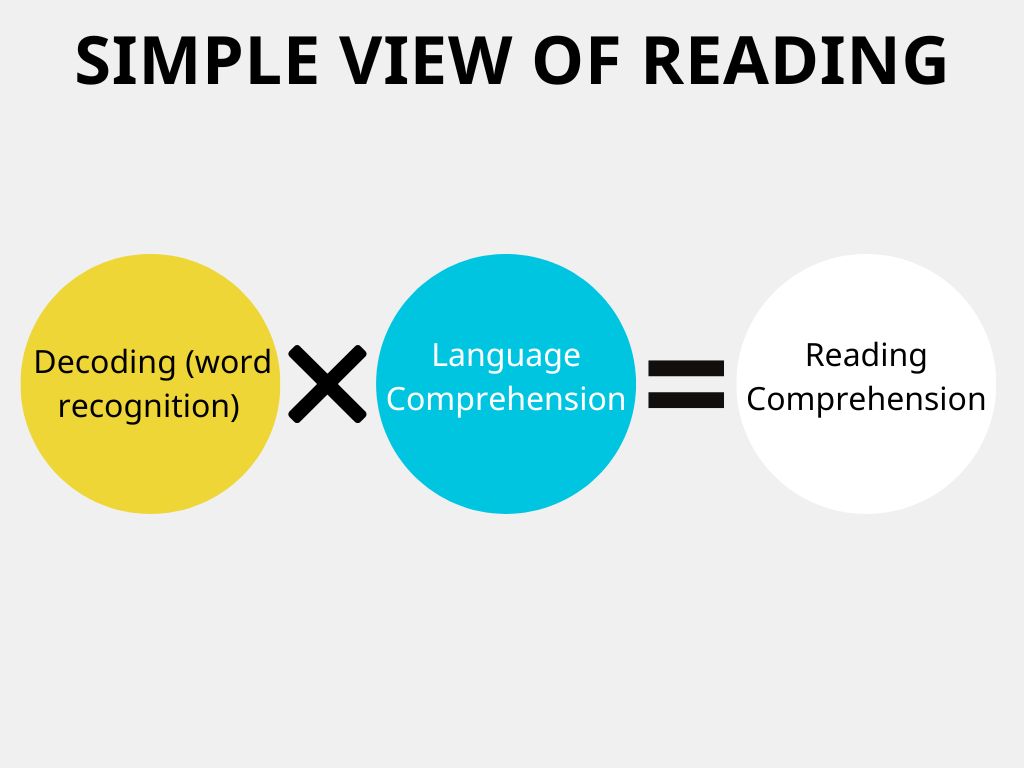The Simple View of Reading is a research-based framework highlighting two essential skills for reading success: decoding (breaking words into sounds and letters) and language comprehension (understanding what those words mean). It’s a simple yet powerful way to assess and support your child’s reading progress.
As an educator, I used to rely heavily on leveled readers to guide instruction. However, I noticed a significant shift when I began tutoring, focusing on the Simple View of Reading. By identifying whether a child needed more support with decoding or comprehension, I saw real, measurable progress in their reading abilities. This blog will explain the model, share how to assess your child’s skills and provide actionable tips to foster growth—whether at home or in collaboration with teachers.
What is the Simple View of Reading?
The Simple View of Reading breaks down a fundamental truth about learning to read: it’s not just one skill but a combination of two. The formula, Decoding (D) x Language Comprehension (LC) = Reading Comprehension (RC), illustrates how these elements work together to create a strong reader. Let’s break it down further:
- Decoding (D) is the ability to recognize and read words accurately and fluently. This includes skills like phonics and understanding the relationship between letters and sounds. Think of decoding as the mechanical skill of reading.
- Language Comprehension (LC) is about understanding the meaning of the words and sentences you read. This includes vocabulary, background knowledge, and the ability to make sense of complex sentences.

If either decoding or language comprehension is weak, reading comprehension (RC) suffers. Since the formula uses multiplication, any gap—whether in sounding out words or understanding their meaning—impacts the overall ability to comprehend text. For example, a child might decode a sentence perfectly but struggle to understand it due to limited vocabulary or background knowledge. On the flip side, a child might have strong comprehension skills but struggle to decode unfamiliar words.
This model connects to broader frameworks like Scarborough’s Reading Rope, which takes a deeper dive into the various skills needed for fluent reading. While the rope adds more layers, the Simple View of Reading provides a quick and effective way for parents like you to assess where your child might need support. To see examples of the Simple View of Reading formula, visit here.
Why It Matters: Understanding this formula empowers you to pinpoint your child’s needs. For instance, if your child excels in decoding but struggles to understand what they’re reading, focusing on language comprehension activities—like discussing stories or introducing new vocabulary—can make a big difference. Similarly, if decoding is the challenge, phonics-based strategies are the way to go. This simple yet powerful framework can guide your approach to supporting your child’s reading journey, one step at a time.
Breaking Down the Formula: Decoding and Language Comprehension
To fully understand how the Simple View of Reading works, it helps to dive deeper into its two main components: decoding and language comprehension. Consider these the building blocks your child needs to become a strong, confident reader.
What is Decoding?
Decoding is the skill of figuring out how letters and sounds come together to form words. It’s what allows your child to look at “cat” and know it says /k/ /a/ /t/. This foundational skill is built through phonics—understanding the connection between sounds (phonemes) and letters (graphemes).
But decoding isn’t just about accuracy; it’s also about fluency or how quickly and effortlessly your child can read those words. A fluent decoder doesn’t have to stop and sound out every word; they can read smoothly, which frees up their brain to focus on understanding what they’re reading.
Quick Tip for Parents: You can support decoding by practicing sound-letter games or reading decodable books designed to build confidence with phonics patterns.
What is Language Comprehension?
Language comprehension goes beyond recognizing words to understanding what those words mean—both on their own and in context. This includes:
- Vocabulary: Knowing the meaning of words.
- Grammar and Sentence Structure: Understanding how words work together.
- Context and Background Knowledge: Bringing prior knowledge to make sense of the text.
Imagine your child reading a sentence about a “vast savanna.” Even if they can decode every letter perfectly, their comprehension might falter if they don’t know what a savanna is or why it’s important in the story. This is where rich conversations, exposure to new ideas, and lots of shared reading come into play.

Quick Tip for Parents: Build comprehension by introducing new vocabulary during everyday activities or discussing stories you read together.
How They Work Together
Decoding and language comprehension are like two wheels on a bicycle. If one wheel is flat, the bike doesn’t go far. Similarly, if a child struggles with either decoding or comprehension, their reading progress will stall.
For example:
- A strong decoder who struggles with comprehension may read fluently but not grasp the story’s meaning.
- A child with strong comprehension but weak decoding may understand spoken stories well but struggle with written text.
The balance between these skills allows a child to truly understand and enjoy reading.
Analogy for Parents: Think of decoding as the gears of a car and language comprehension as the driver. The car (reading comprehension) won’t go anywhere unless both work well together!
How Can Parents Use This Model to Support Their Child?
The Simple View of Reading offers a clear framework to help you identify your child’s reading needs and take targeted action. Here’s how you can put this model into practice at home.
Identify Strengths and Challenges
- Observe Their Reading Behaviors: Watch how your child approaches reading. Do they stumble over words (decoding issues)? Or do they struggle to answer questions about what they’ve read (comprehension challenges)?
- Engage in Book Discussions: After reading together, ask open-ended questions like, “Why do you think the character did that?” or “What do you think will happen next?” Their responses can give insight into their comprehension skills.
- Use Teacher Feedback: Partner with your child’s teacher to review progress reports or assessments. Educators can provide a professional perspective on your child’s strengths and areas for improvement.
- Try Simple Assessments: Tools like word lists for decoding or short quizzes on vocabulary and story understanding can help gauge their skills.
Take Actionable Steps
For Decoding Skills:
- Phonics Practice: Use games like matching sounds to letters or building words with magnetic letters.
- Read Decodable Texts: Choose books that align with your child’s current phonics level, allowing them to practice decoding without frustration.
- Encourage Reading Aloud: Listening to your child read aloud helps reinforce phonics patterns and fluency. Offer gentle corrections when needed.
For Language Comprehension:
- Build Vocabulary: Introduce new words during daily conversations and explain their meanings in context. For instance, while cooking, you could say, “This dough is sticky—like glue!”
- Read a Variety of Books: Share stories that expose your child to different cultures, ideas, and concepts to broaden their understanding.
- Discuss Books Together: Ask your child to retell the story or make predictions. Use follow-up questions to deepen their thinking, like “What do you think the author wanted us to learn from this story?”
Practice Regularly
Focus on small, manageable steps that build on each other over time. This scaffolding approach ensures your child develops confidence and mastery without feeling overwhelmed. Using the Simple View of Reading as your guide, you can give your child the tools they need to become a well-rounded and successful reader!
Collaborate with Educators and Tutors
- Partner with Educators: Stay in regular communication with your child’s teacher to understand their strengths and areas for growth. Ask about how the classroom instruction aligns with research-based methods, such as phonics for decoding and strategies for building comprehension.
- Engage Evidence-Based Tutoring: Programs like TutorJack specialize in individualized instruction that aligns with the Simple View of Reading. TutorJack alternates between 1:1 instruction and small-group practice to address decoding and comprehension needs. This structured approach ensures progress across both components of reading.
- Ask the Right Questions: During parent-teacher conferences or tutor meetings, inquire about your child’s progress. Questions like “Are they meeting decoding milestones?” or “What texts or activities build their comprehension skills?” show you’re informed and invested.
Working together, you, your child’s educators, and evidence-based programs can create a comprehensive plan to strengthen reading skills.
Conclusion: Turning Knowledge into Action
Teachers don’t expect you to master every reading strategy or fully understand complex literacy models like the Simple View of Reading. Instead, they value parents who ask questions, stay curious, and take small, intentional steps to support their children at home. Focus on what feels manageable for your family, whether practicing phonics, having conversations about diverse books, or seeking support from educators and tutors. Remember, consistent, everyday efforts make a lasting difference in your child’s confidence and skills.

